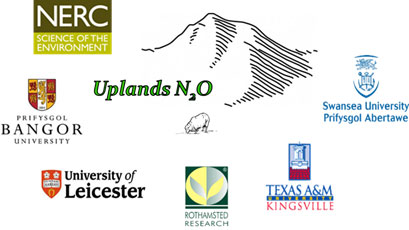Welcome to the Uplands-N2O Research Group
Use the panel on the left to find out about our research, meet the team, check for project updates, view results, view publications and to find contact information.
Project Overview
 NERC: Science of the Environment
Swansea University
Bangor University
Leicester University
Rothamsted Research
Texas A&M University Kingsville
NERC: Science of the Environment
Swansea University
Bangor University
Leicester University
Rothamsted Research
Texas A&M University Kingsville
Urine patches deposited to soils by grazing animals are recognised as hot-spots of emissions of the powerful greenhouse gas, nitrous oxide (N2O). Emissions of this gas from upland, extensively grazed areas, represents a large uncertainty in the national greenhouse gas inventory. With over 5.5 million ha of upland regions in the UK, a significant proportion livestock graze these extensive systems. These areas contrast with the more well studied lowland systems in the range and quality of forage on offer, the soils are generally more acidic and the climate tends to be cooler and wetter.
The overarching aims of the project are to gain an improved understanding of the spatial and temporal interactions between sheep grazing behaviour, forage selection, urine composition and edaphic factors to increase the accuracy of direct N2O emission estimates from extensive upland systems. This will be undertaken using a range of approaches including equipping sheep with GPS and accelerometer tags, analysing urine and vegetation composition, spatially mapping soil and landscape properties which may influence N2O emissions, laboratory and field trials to quantify direct N2O emissions from sheep urine, and data integration and modelling of upland N2O emissions at the pasture scale.
The research is mostly being undertaken at Henfaes Research Centre, where a semi-improved area of enclosed hill land situated approximately 300 m above sea level is the area of study for the first grazing season. The second grazing season will take place within the Snowdonia National Park on an unimproved area situated approximately 850 m above sea level. To find out more about the approaches being undertaken follow the ‘Our Research’ link.
Acknowledgements
We would like to thank our sponsors, NERC, for funding the Uplands-N2O project. We would also like to thank Natural Resources Wales, the National Trust, Snowdonia National Park and Llanfairfechan Graziers Association, for their agreement and support in the use of the unimproved grassland site.






